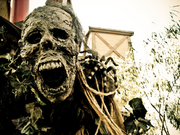The draugr, also called draug, dréag, draugar; draugur, dreygur, or draugen, is an undead creature from Norse mythology. The Old Norse meanings of the word are revenant, undead man, and ghost. Draugar live in their graves, often guarding treasure buried with them in their burial mound. They are reanimated corpses - unlike ghosts, they have a corporeal body with similar, physical abilities as possessed in life.
Folklore[]
One of the best-known draugr is Glámr, who is defeated by the hero in Grettis saga. After Glámr dies on Jól, "people became aware that Glámr was not resting in peace. He wrought such havoc that some people fainted at the sight of him, while others went out of their minds". After a mundane battle, Grettir eventually gets Glámr on his back. Just before Grettir kills him, Glámr curses Grettir because "Glámr was endowed with more evil force than most other ghosts", and thus he was able to speak and leave Grettir with his curse after his death.
Creation[]
After a person's death, the main indication that the person will become a draugr is that the corpse is not in a horizontal position. In most cases, the corpse is found in an upright or sitting position, and this is an indication that the dead might return. Any mean, nasty, or greedy person can become a draugr. As noted by Ármann, "most medieval Icelandic ghosts are evil or marginal people. If not dissatisfied or evil, they are unpopular". This is the prime way that draugr share characteristics with ghosts, since any person can become a ghost. In many Western mythologies, ghosts are generally people with unfinished business or those who are so evil their spirit makes an impact on the place they lived. Ghosts and draugr refuse to follow the prescribed path of death, selfishly staying on Earth when they are supposed to move on. This is easily understandable because, "selfishness is an important attribute of every ghost, and therefore it is no wonder that ghosts tend to be people who were troublesome during their lifetime".
However, unlike ghosts, draugr can also come about through infection by another draugr such as in the story of Glámr. When Glámr arrives in the haunted valley in Grettis saga, "the previous evil spirits are relegated to the sidelines and, when Glámr is found dead, they disappear, whereas he takes over their role as ghost of the valley. Although Glámr is an arguably marginal character to begin with, it is only after his fight with the first malignant spirit that the first spirit leaves the valley, and Glámr takes its place wreaking havoc. Similarly, in Eyrbyggja saga, a shepherd is killed by a draugr and rises the next night as one himself.
Prevention[]

The way of warding off a draugr
The Vikings believed that even if one person was dead, their body could still move and harm other people. A draugr would go around and hurt anyone on his way.
Many precautions were carried out to prevent the draugr from wandering around. Straw would be put under the shroud and a pair of scissors would rest in the chest of the dead. The big toes of the dead were tied together so that he couldn't move.
When the funeral came to the part of transferring the coffin to the grave yard, the bearers would stop before stepping out of the house. They stopped inside, lowering and raising the coffin in three directions to make a sign of scissors. There were times that the dead were carried through the door for the corpse or the "copse door". It was simply a hole in the wall with the brick covered. Once someone died, the bricks would be removed to make the way. Once the ritual was over, it was rebuilt. Because the Vikings thought that the dead would return through the way that they came out. If the dead were buried in the graveyard, there would be an additional ritual that a powerful man would use the magic words to tie the dead to the coffin.
In popular culture[]
Films[]
- In the horror feature film Draug, a group of viking soldiers encounter a draugr during the search mission for a missing missionary, in the northern parts of Sweden.
- A short film titled Draugar heavily features the draugr as the primary antagonists in a post-apocalyptic future where humanity is at war with them. There are two types, Draugr Thralls and the more powerful Draugr Priests.
TV series[]
- Draugar appear in an episode of the third season of Sleepy Hollow. They were referred to as a rare breed of undead warrior that swore an oath in life said to last beyond death.
Literature[]
- In The Morganville Vampires draugr are the ancient enemies of vampires. These draugr are of the sea-draugr sort.
- The villain Surt, in the Norse-inspired novel The Sword and the Satchel by Elizabeth Boyer, is a draugr.
- The barrow-wights of Middle-earth are based on the draugr, since they linger around their gold even after their death and can pass through walls like the normal draugr. Other characters like the Dwimmerlaik and possibly the Great Goblin may be based on draugr too.
Video games[]
- Draugr are featured heavily in The Elder Scrolls V: Skyrim and The Elder Scrolls III: Morrowind (Bloodmoon), in the tombs of ancient Nords. In Skyrim, they are shown as intelligent revenants clad in armor and speaking in the ancient dragon language.
- The "Draug" are villains that walk ashore onto fictional Solomon Island, New England, in The Secret World.
- The video game The Witcher 2: Assassins of Kings features "draugir" as a type of enemy.
- The Vrykul race of World of Warcraft is heavily inspired by the draugr, including variants that turn into seaweed upon death, undead "vargul" and blue-skinned warriors.
- Draugr are a type of enemy in Valheim, appearing often in swamps and the crypts beneath them.
